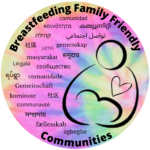Create environments where families and educators work together to normalize, support, and celebrate breastfeeding from infancy through early learning. Childcare and early-education settings are often the first community spaces where families spend time after birth. When parents walk into a center and see they’re welcome throughout the center from drop off locations, to comfortable lactation spaces, staff who understand milk storage, and storybooks that include nursing families, they know their feeding choices are respected. Childcare, preschool, and early education settings shape lifelong attitudes toward feeding and nurturing. When babies and young children see breastfeeding as normal, families receive consistent messages that support their goals. Implementing these steps builds a bridge between home, health systems, and education, ensuring that families experience encouragement across every environment.
STEP 7: The businesses and organizations in the community welcome chest/breastfeeding families.
Step 10: Education systems, including childcare, K-12, colleges and universities, are encouraged to include chest/breastfeeding-friendly curricula at all levels.
Ten Steps to a Breastfeeding Family Friendly Community
Partner with childcare networks.
- Connect with your Child Care Resource & Referral agency, Smart Start partnership, Head Start, or local public-health early-childhood staff.
- Share your community designation process. Each community may select the designation process that best fits its partnerships and goals.
Durham launched its Breastfeeding Friendly Childcare Bundle Project from 2020-2024. Each bundle, every call, and every delivery create something truly valuable to the local community. The relationships built laid a strong foundation, and this project is another step forward in supporting breastfeeding families. We are pleased to share digital folders set up by Breastfeeding Family Friendly Communities of Durham (NC) to help Breastfeeding Friendly Child Care Provider. Each folder contains a number of “Google Docs” and “PDFs.”
How to Get Started in Your Community
- Briefly review the Self Assessment (update with improvement).
- Briefly review the Sample Action Plan.
- Briefly review the Action Plan (fill this out as you read through the sections below and return to it at the end).
Community: Information from Durham, NC, a pilot city, is used to give specific examples. Local communities should substitute local information.
- Review and familiarize yourself with everything in the folder, which includes:
- A list of the Local Community breastfeeding resources (see “COMMUNITY CONNECTIONS STANDARD: Educational materials” for ideas about the community resources that Durham NC collected)
- Information and culturally-appropriate educational materials.
- Print the items to use within your childcare program.
- Update your action plan steps 3, 6, & 9.
- Print the items in this folder, posting them in the public spaces throughout your program to let families know that the program is breastfeeding-friendly.
- Additional resources can be found on the NC DHHS Breastfeeding Friendly Child Care page under “Resources.”
- Note: If you use other materials, please remember that materials you display cannot promote or advertise formula, that is, they cannot be created by a formula company or contain a formula company logo.
- Update your action plan steps 6 & 10.
Professional Development: Local community should substitute local information.
- Take a few minutes to gather all the documentation of your center’s breastfeeding friendly professional development in one location.
- Online Training Options:The recommended online option is CGBI’s Breastfeeding University.
- Completion of the free four online modules will total two hours of cumulative training.
- This might be a great time to have your staff do some online training.
- Update your action plan steps 2 & 10.
- Work on interactive and developmentally appropriate learning opportunities that normalize breastfeeding for children in your program.
- In the digital folder, there are a number of documents that list books and materials that normalize breastfeeding (i.e., games, storytelling, books, toys).
- Complete the CURRICULUM STANDARD with activities and materials that you and your staff put together.
- Our recommended book list
- Update your action plan step 4.
- Review your breastfeeding policy, or write one.
- Review your Breastfeeding Friendly Employer Policy, or write one.
- Review or write your Infant Feeding Plan.
- Review the Milk Storage Guidelines.
- Update your action plan steps 1, 3, 5, 6, 7, & 8.
You are almost done!
- Update your Self Assessment.
- Update your Action Plan.
We thank you for your interest in supporting breastfeeding families. We are happy to assist in any way you may find helpful. Please do not hesitate to contact us.
For help or support email: Breastfeeding Family Friendly Communities
Video Training Series
- Breastfeeding Friendly Childcare – An Overview
- Normalizing Breastfeeding Throughout Your Program
- Breastfeeding Supports in the Classroom – Environments
- Breastfeeding Supports in the Classroom – Curriculum
- Feeding Infants – Paced Bottle Feeding and Child-Led Weaning
- Communicating with Families about Breastfeeding
- Creating a Lactation Space
- Applying for Breastfeeding Friendly Designations
- Writing a Breastfeeding Policy – Part 1
- Writing a Breastfeeding Policy – Part 2
More Resources
- New South Wales (NSW, Australia), Southern NSW Local Health District: Encouraging and Supporting Breastfeeding in Childcare Resource Kit
- Wisconsin Breastfeeding Coalition Breastfeeding Friendly Child Care
